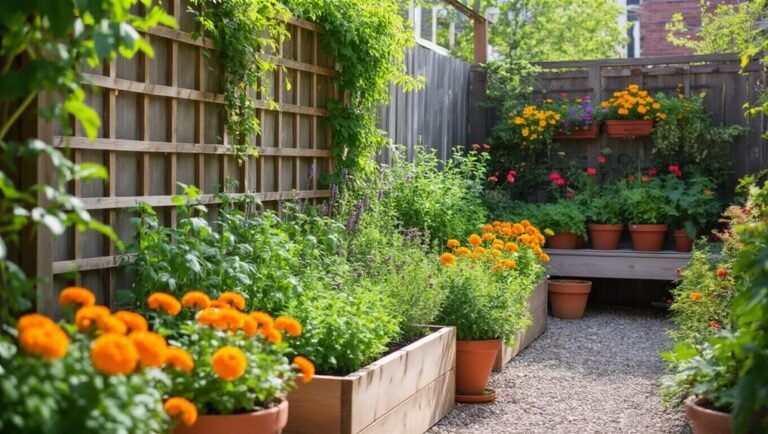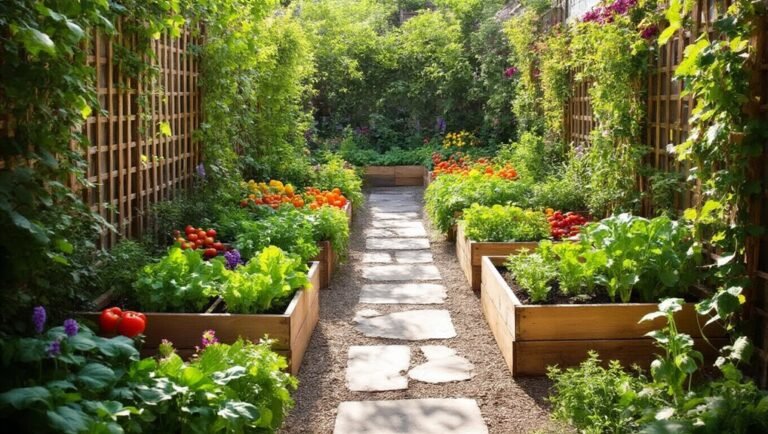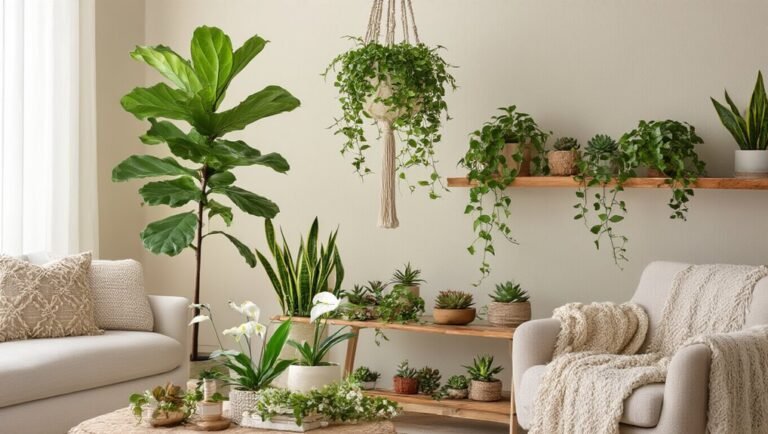To create a stylish and functional home garden, start by choosing plants that suit your climate and space. Design an inviting layout with pathways and vertical elements to enhance access and visual appeal. Incorporate sustainable practices, like using native plants and composting, for a healthier environment. Add personal touches with decorative items and cozy seating areas. With the right maintenance routine, your garden will flourish. Discover more tips for transforming your outdoor oasis into a retreat.
Key Takeaways
- Choose plants that suit your climate, sunlight, and garden purpose for a cohesive and beautiful design.
- Design functional layouts with pathways and vertical elements to maximize space and accessibility.
- Incorporate sustainable practices like native plants, composting, and organic methods for an eco-friendly garden.
- Add decorative elements such as sculptures, seating, and lighting to enhance the garden’s aesthetic appeal.
- Establish a maintenance routine for watering, weeding, and pruning to ensure long-term garden health.
Choosing the Right Plants for Your Space
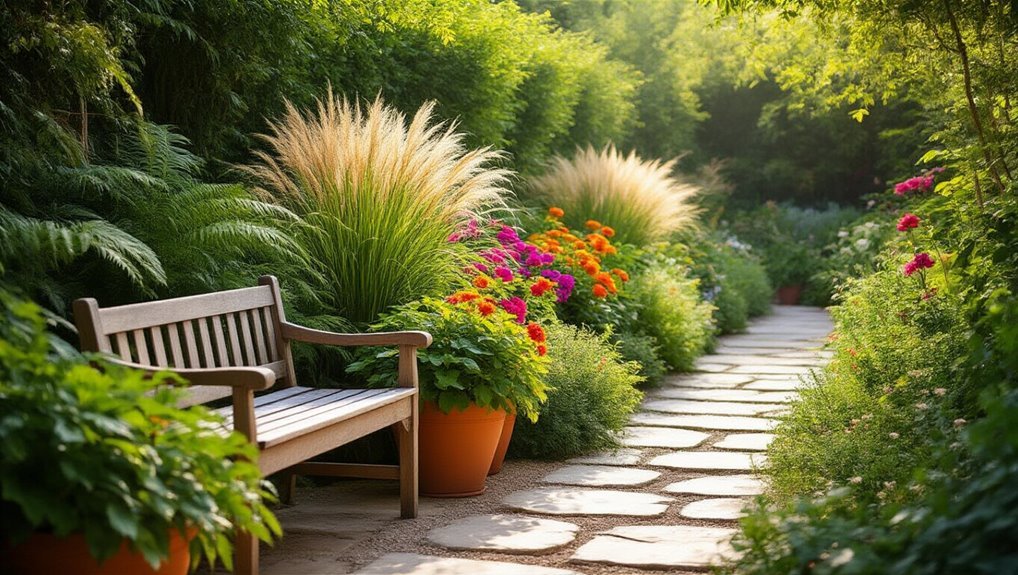
Choosing the right plants for your space can make all the difference in creating a thriving home garden.
Start by considering your climate and sunlight levels; some plants love full sun, while others thrive in shade.
Think about your garden’s purpose—are you looking for beauty, edibles, or a mix? Choose plants that fit your lifestyle. Using a seed starting kit can also help ensure your chosen plants get the best possible start, no matter your experience level.
If you’re busy, opt for low-maintenance varieties that don’t require constant care.
Also, consider the size of your space; larger plants might overwhelm a small area, while tiny plants can get lost in a vast garden.
Lastly, don’t forget about seasonal changes. Select a variety of plants that bloom at different times to ensure year-round interest and vitality in your garden.
For beginners or those looking for convenience, Herb Garden Kits with Seeds and Pots offer an easy way to start growing fresh herbs right at home. Happy planting!
Designing Functional Garden Layouts
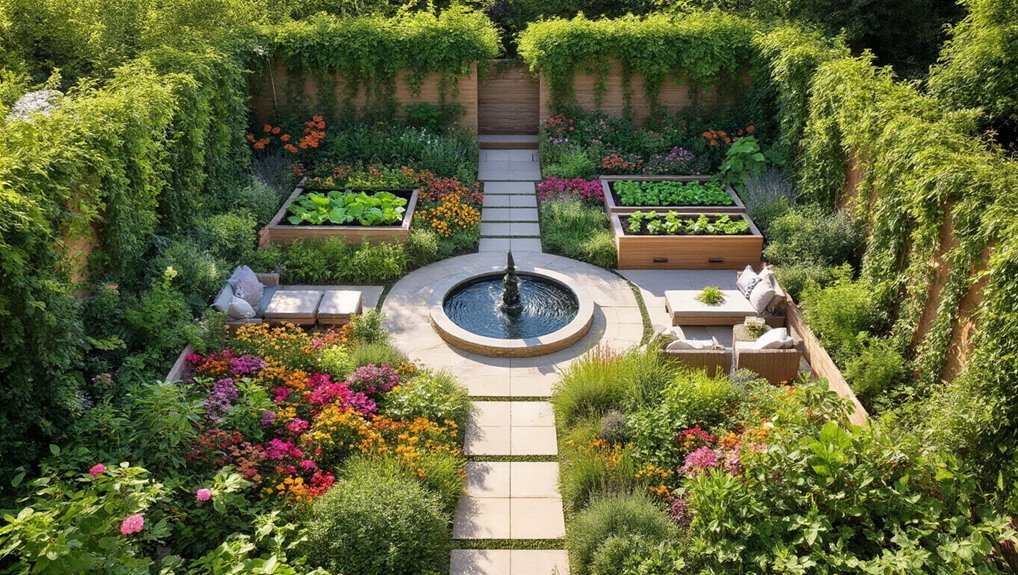
Once you’ve selected the right plants for your garden, the next step is to design a layout that maximizes both functionality and aesthetics. Adding quality trellis netting to your garden can provide sturdy support for climbing plants and help organize your growing space more efficiently.
Start by considering the sun and shade patterns throughout the day. Group plants with similar light and water needs together to simplify maintenance.
Use pathways to create easy access, ensuring you can reach every area without trampling your plants. Incorporate vertical elements like trellises to save space while adding visual interest.
When choosing beautiful trellises, you not only support climbing plants but also enhance your garden’s overall appeal.
Don’t forget about seasonal changes; plan for blooms and foliage that provide year-round appeal.
Finally, think about how you’ll use the space—whether for entertaining, relaxing, or growing vegetables—so your garden meets your lifestyle needs effectively.
Incorporating Sustainable Gardening Practices
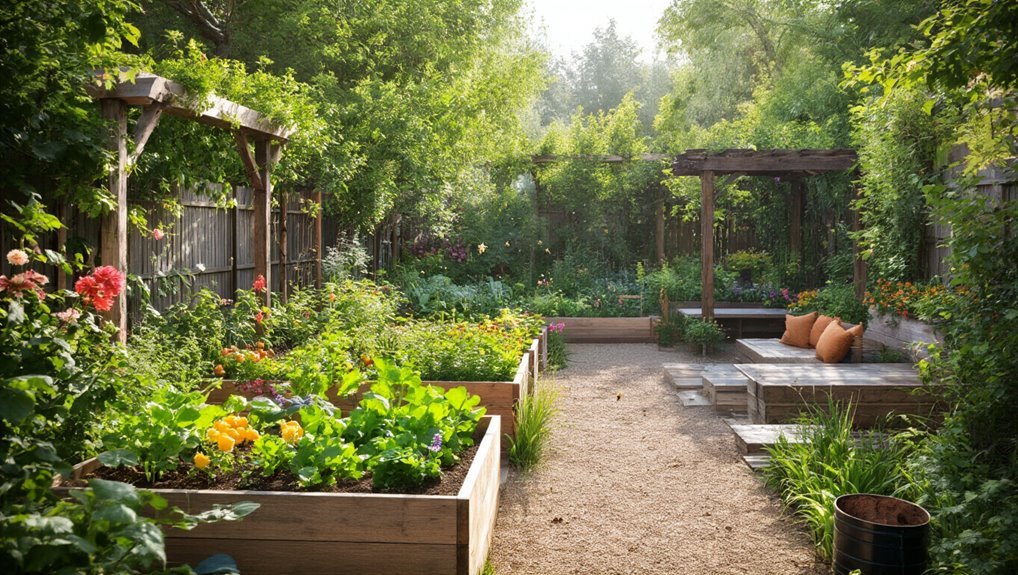
As you embark on your gardening journey, incorporating sustainable practices can’t only enhance the health of your garden but also benefit the environment.
Start by choosing native plants that require less water and are naturally resilient to local pests. Implement composting to recycle kitchen scraps and enrich your soil, reducing waste. Use organic fertilizers and pest control methods to minimize chemical use. An effective approach is to explore organic pest control solutions, which help maintain a healthy ecosystem while protecting your plants.
Consider rainwater harvesting to conserve water and ensure your plants thrive during dry spells. Practicing crop rotation can help maintain soil fertility and reduce disease risks.
Lastly, create habitats for beneficial insects and pollinators by including diverse plant species. By adopting these sustainable techniques, you’ll cultivate a flourishing garden that’s eco-friendly and truly rewarding. Adding a compost bin to your gardening setup is an effective way to manage organic waste and create nutrient-rich soil for your plants.
Adding Decorative Elements and Personal Touches
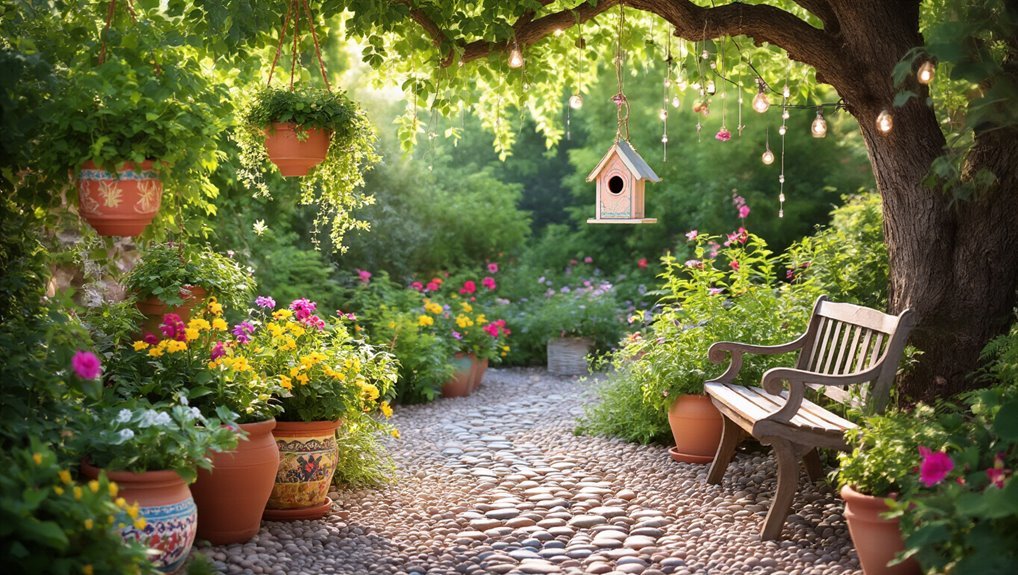
While creating a garden that thrives is important, adding decorative elements and personal touches can make it truly unique and inviting.
Consider incorporating a variety of decorative planters, garden sculptures, or whimsical ornaments that reflect your personality. You could also hang string lights or lanterns for a cozy atmosphere during evenings. Introducing decorative birdhouses for gardens can provide both visual appeal and a welcoming habitat for local birds.
Don’t forget to add seating areas with colorful cushions where you can relax and enjoy your surroundings.
Personal touches like handmade birdhouses or a small water feature can enhance the ambiance and attract wildlife.
Lastly, using vibrant garden art or even DIY projects can showcase your creativity.
With these elements, your garden won’t only flourish but also tell your story, creating a space that feels like home.
For an extra touch of elegance and character, consider adding beautiful garden statues as focal points throughout your space.
Creating Outdoor Living Areas
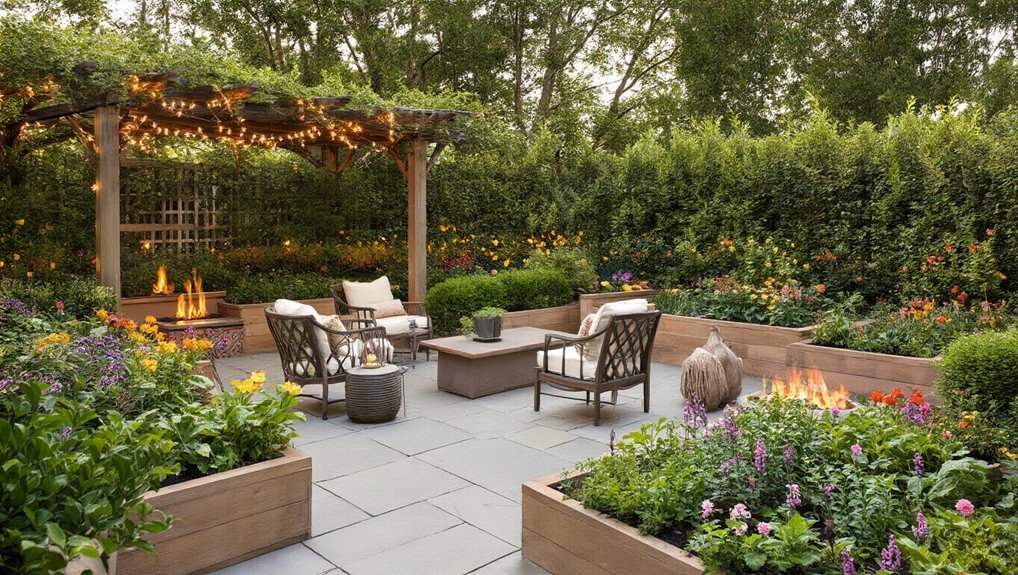
Start by defining spaces with furniture like a cozy seating arrangement or a stylish dining set. Choose materials that blend seamlessly with your garden’s aesthetic. Add shade with pergolas, umbrellas, or canopies for comfort during sunny days. To keep your outdoor pieces looking their best, consider protecting them with outdoor furniture covers specifically designed for garden furniture.
Incorporate lighting to create ambiance; string lights or lanterns can transform your space into a magical retreat in the evening.
Don’t forget to include greenery, like potted plants or vertical gardens, to enhance the vibe. Lastly, consider adding a fire pit or outdoor heater for warmth and gathering.
Adding outdoor garden benches can offer both functional seating and a decorative touch to your outdoor living areas.
With these elements, you’ll craft a perfect outdoor haven for relaxation and entertaining, making the most of your home garden.
Maintaining Your Garden for Long-Term Success
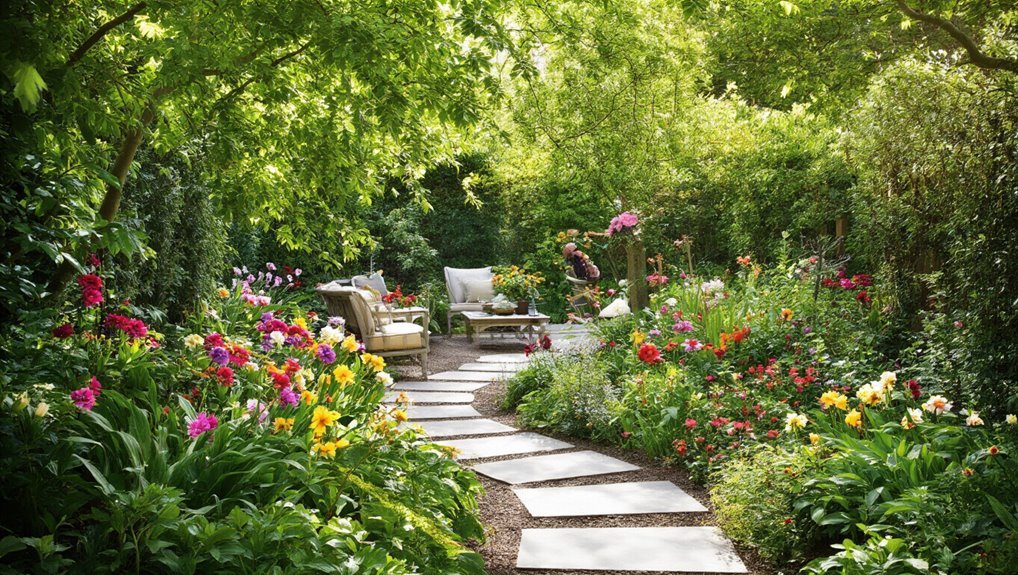
To ensure your garden thrives over the long term, you need a consistent maintenance routine that addresses its unique needs.
Regular attention will keep your plants healthy and help prevent pests and diseases. Here are a few essential tasks you should incorporate into your routine:
- Watering: Ensure your plants receive adequate moisture, especially during dry spells. Adjust the frequency based on the season and plant type.
- Weeding: Regularly remove weeds that compete for nutrients and water. This not only enhances aesthetics but also promotes the health of your plants. For effective weed removal and soil care, garden shovels are a must-have in every gardener’s toolkit.
- Pruning: Trim back dead or overgrown branches to encourage new growth and improve air circulation.
For the best results, consider investing in pruning shears designed specifically to make trimming easier and more precise.
Frequently Asked Questions
What Are the Best Gardening Tools for Beginners?
For beginners, you’ll want essential tools like a hand trowel, pruners, a garden fork, and gloves. These items help you plant, maintain, and enjoy your garden without becoming overwhelmed or frustrated. Happy gardening!
How Do I Attract Pollinators to My Garden?
To attract pollinators to your garden, plant a variety of colorful flowers, avoid pesticides, and provide water sources. Group plants in clusters, and consider native species; they’ll draw bees, butterflies, and other beneficial insects.
What Is the Best Time to Plant Vegetables?
In the symphony of seasons, you’ll find spring’s gentle embrace is the best time to plant vegetables. Aim for after the last frost, when the earth awakens, nurturing your seeds into vibrant life.
How Can I Prevent Pests Naturally?
To prevent pests naturally, you can use companion planting, introduce beneficial insects like ladybugs, or create barriers with row covers. Regularly checking your plants helps you spot issues early and maintain a healthy garden.
What Are Some Low-Maintenance Plants for Busy Homeowners?
If you’re juggling a hectic schedule, consider succulents, snake plants, or pothos. These resilient beauties thrive with minimal care, bringing life to your space while you focus on what truly matters—your busy life.
Conclusion
As you step back to admire your garden, a sense of accomplishment washes over you. Every plant, layout, and decorative touch tells a story—your story. But as the seasons change, will your garden evolve with them? The real journey begins now, as you cultivate not just plants but memories and experiences. Embrace the unknown, for each bloom holds a secret waiting to unfold. Your garden’s future is in your hands, and it’s full of possibilities.
